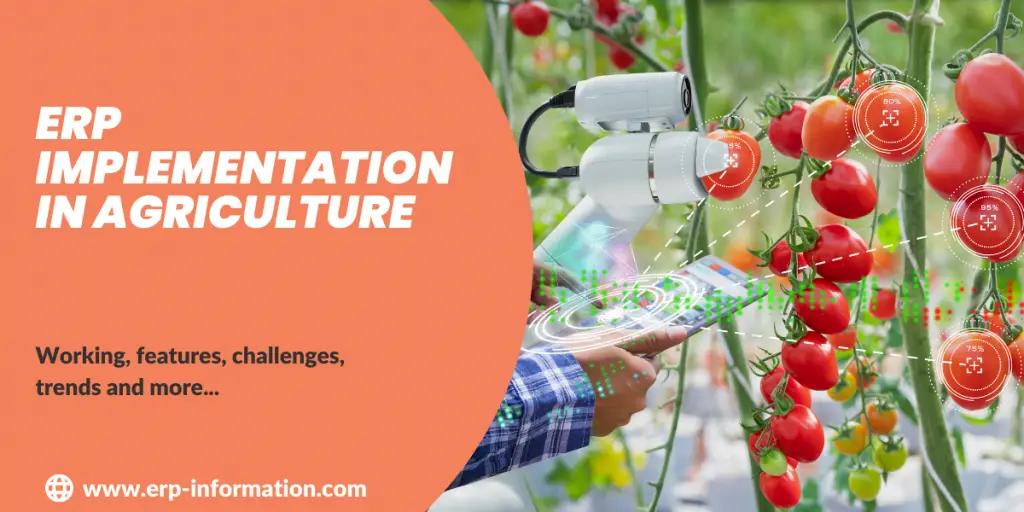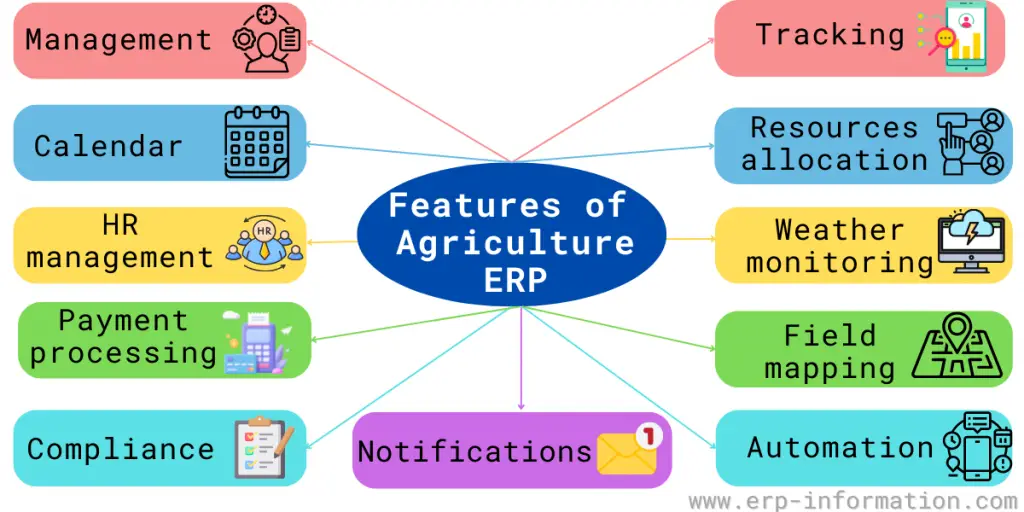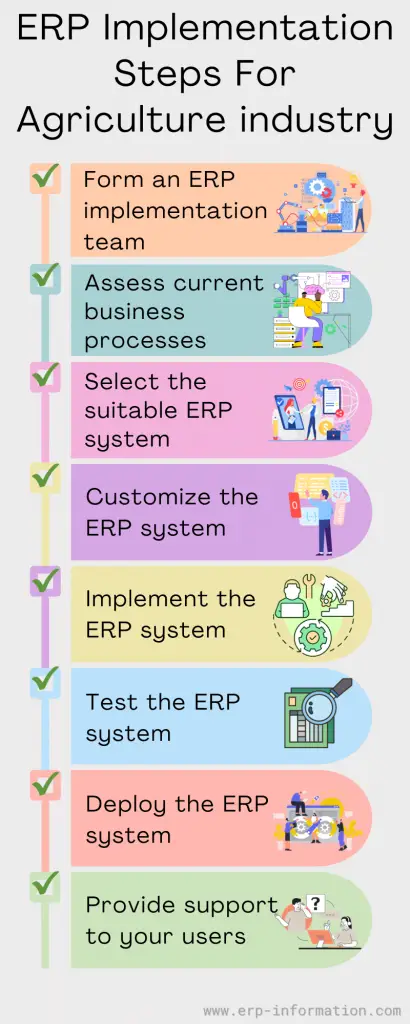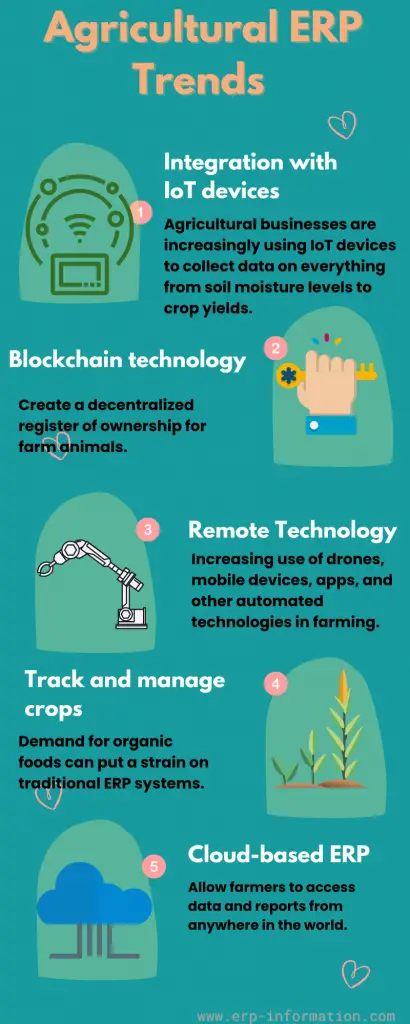Farmers have a lot of work to do and must manage their time and resources as efficiently as possible. They are always looking for ways to improve their productivity and efficiency, but it can be hard to keep up with the latest technological advancements.
ERP implementation in agriculture can help farmers manage their time and resources more efficiently by automating processes.
In this blog post, we will explore the definition of ERP implementation in agriculture and its working; we also discuss its features, ERP implementation steps for agriculture, then the challenges of implementing the system, followed by trends and benefits.
ERP Implementation in Agriculture
Agricultural ERP systems help farmers improve their operations by giving them a comprehensive view of all areas of their business.
This includes things like finances, inventory, scheduling, and more. This readily available information can help farmers make better decisions that boost efficiency and profitability.
There are several different agricultural ERP implementations, each tailored to fit the specific needs of other farms. However, they all share some standard features.
For example, most agricultural ERP systems will track inventory levels and automatically order supplies when stock gets low.
This can save farmers time and money by preventing them from manually keeping tabs on their inventory levels.
How Does It Work?
- ERP in agriculture begins by organizing all the data collected from the various fields into a single system.
- Once this is done, a report can be generated showing production levels, inventory levels, and financial data.
- This report can then be used to make informed decisions about planting, harvesting, and selling crops.
- The next step is to create a plan that will help improve efficiency and coordination between the various departments in the agricultural company. This plan should include details about how tasks will be assigned, what resources will be needed, and when tasks need to be completed.
- Once the plan is in place, it must be implemented and monitored regularly.
Features of Agriculture ERP
- Management: Managing inventory and production planning for crops, livestock, and other agricultural products.
- Tracking: Tracking orders from customers (farmers, grocery stores, etc.) and fulfilling them accordingly.
- Calendar: The breeding calendar helps track when animals are bred and conceived so that production can be planned accordingly.
- Resources allocation: Allocating resources (land, water, labor) to different areas of production as needed.
- HR management: HR integration allows the human resources department to manage employee data and records within the ERP system.
- Weather monitoring: Monitoring weather conditions and forecast data to decide planting/harvesting schedules, etc.
- Payment processing: Processing payments from customers and managing invoices/billing information.
- Compliance An ERP system can facilitate compliance with government regulations by providing a complete record of all transactions and activities related to agriculture.
- Field mapping Allows farmers to view their land and crops in a digital map format, which can help with strategic decision-making about planting and harvesting.
- Automation: Automates various processes related to agriculture, such as spraying, irrigation, harvesting, etc.
- Notifications: Assists in monitoring the prices of agricultural commodities in the market and alerts the farmers about price fluctuations.
ERP Implementation Steps in Agriculture
- Form an ERP implementation team: The team should be composed of representatives from all departments of the agricultural business and an ERP consultant. The team takes responsibility for planning, implementing, and managing the ERP system.
- Assess current business processes: ERP Implementation in Agriculture will help you to identify areas where improvement is needed and to develop a plan for streamlining your processes.
- Select the suitable ERP system: There are a number of ERP systems available on the market, so it is important to select one specifically designed for the agricultural industry and that meets the specific needs of your business.
- Customize the ERP system: Once you have selected an ERP system, you will need to customize it to meet the specific needs of your business. This may involve developing custom modules or configuring the system to match your existing business processes.
- Implement the ERP system: It is a complex process that should be carefully planned and managed. It is important to train your employees on the new system and to provide them with support during the transition period.
- Test the ERP system: Once the ERP system is implemented, you should thoroughly test it to ensure that it is working properly. This includes testing all of the system’s features and functionalities.
- Deploy the ERP system: Once you are satisfied with the testing results, you can deploy the ERP system to your users.
- Provide support to your users: After the ERP system is deployed, you should provide support to your users to help them learn the new system and troubleshoot any problems they may encounter.
Challenges of Implementing ERP in Agriculture
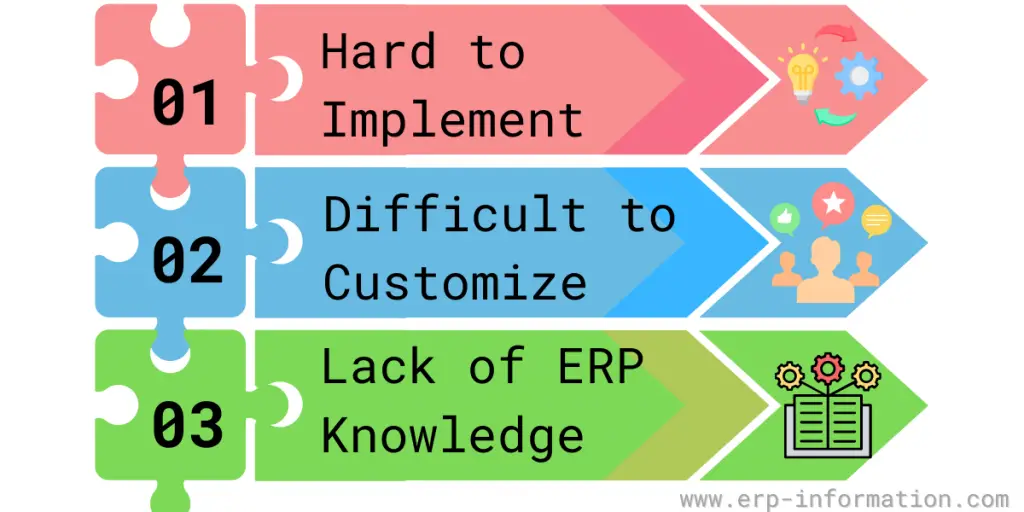
The Challenges of implementing ERP in agriculture are numerous and varied. They include
Hard to implement
It is difficult to implement because of the lack of reliable broadband internet service in rural areas, the cost of software and hardware, the need for specialized skills to operate and maintain an ERP system, and the reluctance of some farmers to adopt new technology.
Difficult to customize
Another challenge is that most ERP systems were designed for manufacturing companies, not farms.
As a result, they are often too complex or expensive for small family farms, and they can be difficult to customize to meet the specific needs of agricultural businesses.
Lack of ERP knowledge
There is also a shortage of qualified personnel with knowledge about ERP systems and agriculture, making it difficult for many farmers to find someone to help them implement an ERP system correctly.
Agricultural ERP Trends
The agricultural industry is constantly evolving, and new ERP system trends have come. Here are a few of the latest agricultural ERP trends seen in the agricultural ERP space.
Integration with IoT devices
Agricultural businesses increasingly use IoT devices to collect data from soil moisture levels to crop yields. This data can be precious in optimizing operations, but only if it can be appropriately analyzed and incorporated into an ERP system.
The best agricultural ERP systems will offer seamless integration with popular IoT platforms.
Blockchain technology
This can be used to create a decentralized register of ownership for farm animals. This would allow for more efficient livestock management and provide a transparent record of provenance for food products.
Additionally, blockchain could be used to create a system for tracking crop production.
Remote technology
Increasing use of drones, mobile devices, apps, and other automated technologies in farming. That can help farmers increase efficiency and reduce costs.
Track and manage crops
Demand for organic foods can put a strain on traditional ERP systems. Farmers must be able to track and manage their crops and inventory carefully to meet these demands.
Cloud-based ERP
These systems are becoming more popular in the agricultural industry as they allow farmers to access data and reports from anywhere in the world.
Benefits of ERP Implementation in Agriculture
Implementing an enterprise resource planning (ERP) system in agriculture has many benefits.
Improves communication
An ERP system can help improve communication and coordination between different departments within an agricultural organization and between different organizations involved in the agricultural supply chain.
Effective decision-making
An ERP system can provide real-time visibility into inventory levels, farm assets, and other data, which is critical for effective decision-making in the agricultural sector.
Improves efficiency and reduces costs
ERP systems can help to improve communication among farmers, distributors, and retailers. That can help to improve the flow of information and reduce the need for manual input, which can lead to mistakes.
By automating and integrating various business processes, an ERP system can also help to improve efficiency and reduce costs.
Manages finance
ERP systems can help farmers to track inventory, monitor prices, and plan production schedules. ERP systems can also help farmers manage their finances and track expenses.
Utilization of agricultural land
It helps maintain the land records and keep track of the utilization of agricultural land.
FAQs
How long does it take to implement an ERP system in agriculture
It usually takes about two years to implement an ERP system in agriculture fully. There are many moving parts when it comes to implementing such a comprehensive system, and it’s essential to take the time to do it right so that the benefits can be fully realized.
There are a lot of factors that go into choosing the right ERP system for an agricultural business. Each business is different, and each will have its own specific needs.
The key is finding a system that can meet those needs and is also compatible with the other systems currently in use. Once that’s done, then the implementation process can begin in earnest.
List 10 best ERP software for agriculture
Many agricultural ERP software programs can help with agricultural production, but these are our top 10:
1. Tilapia Farming Management System (TFMS)
2. FarmNXT
3. myfarmbase
4. fielddoc
5. Agrivi
6. FynByz tech
7. Folio3 dynamics
8. Agri ERP
9. HUSPI
10 Grossman software
What are some of the main features one should look for in an ERP software solution for agriculture?
When choosing an ERP software solution for agriculture, there are some main features that you should look for, such as:
* Comprehensive functionality: Should be able to cover all aspects of your agricultural business, from crop management and livestock management to financial management and HR management.
* Ease of use: The software should be easy for you and your employees.
* Affordability: Affordable platform for your agricultural business budget.
* Scalability: Possess the capability to scale alongside your business as it experiences growth.
* Integration: Ability to integrate with existing systems, like accounting software and CRM systems and others.
* Support: The software provider should offer good customer support.
Conclusion
ERP Implementation in agriculture helps farmers and their workers to manage the entire business process.
This system has different features which make it efficient for agricultural use. With the ever-growing population, finding ways to increase food production has become increasingly important.
ERP implementation in agriculture can help us achieve this goal. Have you considered using an ERP system for your farm or agricultural business? If not, now may be the time to consider this option.
Reference
